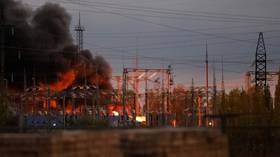Why ‘lone wolf’ attacks are becoming a major feature in modern terrorism

The strengthening of counterterrorism measures by Western states has forced terrorists to abandon their normal tactics and switch to a new, destructive strategy – individual jihad, or so-called “lone wolf” terrorism.
Last December a UK court found two Nigerians, Michael Adebolajo, 28, and Michael Adebowale, 22, guilty of killing English soldier Lee Rigby in front of dozens of passersby in the southeast London district of Woolwich. The soldier was dismembered with a hatchet in broad daylight on May 22, 2013. The horrific scene was recorded on witnesses’ mobile phones, with one of the murderers warning of more violence as the soldier lay on the ground. The two young men will be sentenced in January 2014.
No connection between the two young men and terrorist groups was proven, and Adebolajo claimed in police interviews that the killing was justified because the pair were engaged in a holy war in retaliation for the deaths of Muslims in Afghanistan at the hands of British troops. Later, Al-Qaeda issued a statement praising its “brothers” for choosing “lone wolf” jihad tactics.
Around 2011, the rise of individual jihad began to be noticeable. This was partly provoked by the fact that the West significantly increased its counterterrorist measures, mobilized the intelligence services, and strengthened control over the media – especially the Internet. These measures created serious challenges for terrorist organizations. Moreover, many leading theorists and practitioners of jihad were killed or seized during operations led by the US Army. The new ideologists of Al-Qaeda found a solution – carrying out terrorist attacks in countries where counter-terrorism measures were weaker, such as Syria and Mali.
Jihad on open fronts means that the mujaheddin hold under their control certain territories with settlements that serve them as a base for mobilization and concentration of their forces, training and recovery. In other words, jihad took the form of open confrontation with their opponents.
However, the considerable technical advantage of the US Army and its Western allies complicated this strategy. It became necessary to find a new concept of fighting. And that’s how the ideas of individual terrorism, also known as “lone wolf attacks,” began to become more widespread.
Yemeni Commander Qassim Ar-Reimy, May 2013: “The two decade war has not laid down its burden, rather it is at its peak. The war between you and us has not ceased, we suffer hardships and you suffer too, we are killed as you are killed but we have a hope from Allah (for the reward, i.e. Paradise) that for which you hope not.”
The concept of individual jihad assumes the commission of terrorist attacks by people who aren't part of any organizations.
It’s quite easy to discover the idea of individual jihad, which could be done just by visiting websites of radical Islamists or reading the Inspire online magazine, for example. The Inspire magazine has been published since 2011 by Al-Malahem media, which is a propaganda division of Al-Qaeda in the Arabian Peninsula (AQAP). The journal is published every seven to 10 months, and is usually about 70 pages. The very fact that AQAP publishes such an English-language journal devoted to the ideology and methods of individual jihad, describing in details how to create a bomb at home or how it is better to commit an attack, means a lot.

The latest issue of Inspire (Spring 2013) started with a warning letter from the editor, saying: “The war is yet to cease, it has barely started. Yesterday it was Baghdad, today it is Boston. The question of 'who and why' should be kept aside. You should be asking, ‘Where is next?’” Probably, you’d think this phrase relates to the Boston attacks, but there are still too many questions to answer, and the actual court trial will only begin in June. But among AQTweets (tweets of mujahedin in the Arabian Peninsula collected by Al-Malahem media for Inspire magazine) there is a comment on Boston attack made by Abul Kheir Al-'Adany: “They say the bros arent AlQaeda, they are lone wolves. That z wat ALQ wants, the #jihad project to be da ummah's prjct, I blve we are winning.”
As for the journal, there have been discussions about the journal’s authenticity, links with Al-Qaeda leaders and possible impact on its readers, but nevertheless, no agreement on its dangerous potential has been reached. At the same time, Inspire was founded as a means to attract Western jihadists and sow seeds of extremism within the enemy countries (USA and UK) themselves. All attempts to ban it, (not that many, to be honest) failed. It happened only a few times that the content of Inspire was damaged by viruses and its links were inaccessible. So the question arises ‘how does AQAP manage to maintain its accessibility?’ Either terrorists have very good IT skills that enable them keeping their websites secure from intelligence services – or nobody really fights the spread of extremism.

It’s not a secret that there are also various agencies serving Al-Qaeda’s leaders that are aimed at propaganda and distance training, Al-Masada, Al-Furqān, Global Islamic media front (GIMF) among them. The most modern and developed Jihadist agency is Nukhbat al-Islam al-Jihadi, which actively uses Facebook, YouTube and Twitter, providing its online followers with documentaries, articles and propaganda speeches.
The “lone wolfs” do not plan to target particular people. Indeed, in terrorist acts in London, Paris and Boston victims were ordinary people, but not politicians or the military top brass. Moreover, acts of individual jihad somehow lead to military and political success, as such actions make the targeted governments adjust their policies and legislation in the security field, and they also spread panic among the population. The main advantage of such terrorist acts is that the Western intelligence services can't prevent them. “Lone wolves” don't join any groups, it isn't necessary to belong to a terrorist organization to commit an individual jihad attack. They don't go to the field for training, they continue to live in the same countries they lived in before discovering extremist ideas.
As regards the safety of individual jihad, there is no need to search for reliable channels or contact certain people from terrorist groups when the possibility of being caught during the preparations is very high, as well as chances to entrust your destiny to the “man of straw” from the intelligence services. “Lone wolves” do not depend on anybody.
Consequently, individual jihad is often carried out by ordinary people, and the act of terrorism has a very primitive character. The training isn’t really needed, some video uploaded to YouTube or discussions at Jihadist groups at Facebook would be enough for basic knowledge. The very sense of “lone wolf” attacks is based on passion and desire to fight the kafirs (infidels) by all possible means. The purpose of individual jihad isn't limited to any framework – any person, irrespective of skin color, religion, nationality and social status, can be targeted. As for the weapon, anything can be used for the attack, from an ordinary kitchen knife or an iron rod to a gun or homemade bomb.
“Lone Jihad is impossible to counter and stop, except when basic cooking ingredients and building material become illegal!” Inspire magazine, spring 2013, Issue 11
One of the main theorists of individual jihad is Abu Musab al-Suri, who originates from Syria. He is also one of the authors of the Inspire magazine and well-known paper “The school of individual jihad and small cell terrorism.” According to this work, the purpose of resistance and individual jihad is to cause as much human..
One of the main theorists of individual jihad is Abu Musab al-Suri, who originates from Syria. He is also one of the authors of the Inspire magazine and well-known paper “The school of individual jihad and small cell terrorism.” According to this work, the purpose of resistance and individual jihad is to cause as much human and material damage to America and its allies as possible, and let them know that resistance became a phenomenon, became public revolt against their hostility which extends from Central and Southern Asia, the Philippines and Indonesia in the east, to the Atlantic coast in the West, and from the Caucasus, the Balkan states and North Africa in the north to India and Central Africa in the south, throughout the whole Islamic world, and regions with Muslim population.
Individual jihad is not limited by the US, Russia or UK borders. It’s a worldwide phenomenon. Examples are easy to find: killing of soldiers on the Fort Hood military base by Nidal Malik Hasan in 2009; Abdulhakim Muhammad’s attack on the Arkansas Military Recruiting Station in 2009; British MP Stephen Timms stabbed by female Pakistani student Roshonara Choudhry in May 2010; murders committed by Mohammed Merah in Toulouse and Montauban in 2012.
Although individual jihad has lots of faces and variations, we can still figure out several common features: nobody stands behind this act of terrorism, and it is a sudden, unplanned attack committed by a person who was not in contact with anyone from terrorist organizations. Radical ideas are often found on the Internet since, apart from various websites that contain articles and video materials, extremist information can easily be found in popular social networks such as Facebook and Twitter. All this creates fertile ground for the growth of “home terrorism.”
Irina Sukhoparova, RT
The statements, views and opinions expressed in this column are solely those of the author and do not necessarily represent those of RT.
The statements, views and opinions expressed in this column are solely those of the author and do not necessarily represent those of RT.













